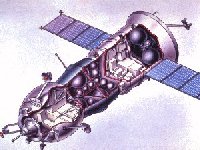
Soyuz 19 space capsule used to dock with Apollo 18. Notice the docking port in the front of the craft.
Image scanned from Quest for Space by C. Bongiorno

The craft consisted of three parts, a spherical orbital section, the crew section, and the service module. The orbital section housed the capsules scientific equipment, and was where most of the research was conducted on these craft. The crew section could hold up to three cosmonauts. These craft were primarilly responsible for the ferrying of crew and supplies up to Russia's successful series of space stations, Salyut and Mir.

When the ship was ready for reentry, the orbital module would seperate from the front of the craft. Then, the breaking thrusters would fire on the service module, allowing the ship to slow and fall towards the Earth. The crew module would then seperate, falling through the atmosphere. The crew module was equipped with parachutes to slow its fall before impact. In addition, thrusters were added to the bottom of the crew module which fired just before impact.
Along with Apollo 18, Soyuz IX made a historic spaceflight in 1975 when the two craft docked together in orbit. Making his second appearence in the history books was Cosmonaut Commander Aleksei Leonov, who had also been the first human who had performed a spacewalk in Earth orbit. This flight was also historic for the Americans because it marked the last use of the Apollo class of space capsules. The Americans did not send a man into space untill 1980, with the launch of the Enterprise class space shuttle Columbia.
Unfortunately, the Soyuz program also had the distinction of having the first space related fatality in the history of the Terran space program. On April 24, 1967, Vladimir Komarov was killed in Soyuz I when the parachute became entangled during landing, causing the capsule to hit the Earth too hard. Also, on June 30, 1971, the entire crew of Soyuz 11, Georgi Dobrovolsky, Vladislav Volkov, and Victor Patsayev, all died because of decompression caused by a valve that stayed open when the capsule disconnected from the Salyut space station. After that tragic accident, all of the 3-man Soyuz capsules were converted to 2-man ships, with the extra space being reserved for preasure suits in case such an event happened again. By 1979, the Soyuz capsules were replaced by the Soyuz T model, which was again capable of carrying 3 people. This variant remained in use through the beginning of the 21st century.

Length: 8.7 m
Diameter: 7.3 m
Mass: 6690 kg
Crew: 3
Propulsion: Chemical Rockets
